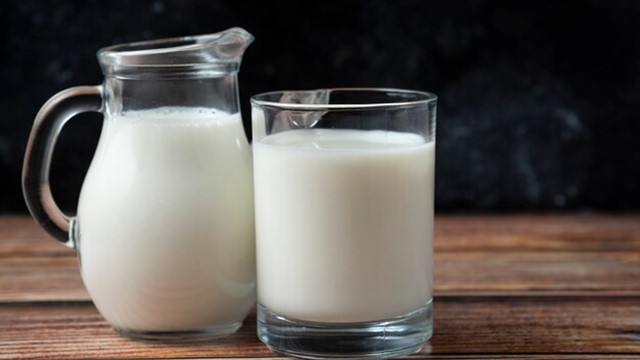Milk is a nutrient-rich, opaque white liquid produced by mammals, typically by female mammals to feed their young offspring. It serves as the primary source of nutrition for infant mammals before they can consume solid food.
In human consumption, cow’s milk is one of the most commonly consumed types, but milk from other mammals such as goats, sheep, buffalo, and even camels is also consumed in various parts of the world. Each type of milk has its unique taste, nutritional composition, and uses.

Key Components of Milk:
Milk is a complex liquid composed of various essential components that contribute to its nutritional value and composition. The key components of milk include:
Water:
- Milk is predominantly water, making up the largest percentage of its content. It serves as the base in which other components are dissolved or suspended.

Carbohydrates (Lactose):
Lactose is the primary carbohydrate found in milk, providing energy to the body. It consists of glucose and galactose and is responsible for the slightly sweet taste of milk.

Proteins:
- Casein: Casein makes up the majority (about 80%) of the total protein content in milk. It is a high-quality protein that is digested slowly, providing a sustained release of amino acids.
- Whey: Whey proteins, comprising about 20% of milk’s protein content, are quickly digested and contain essential amino acids. They play a role in muscle growth and repair.

Fats:
Milk contains various types of fats, including saturated fats, unsaturated fats (such as monounsaturated and polyunsaturated fats), and small amounts of cholesterol. Fats in milk provide energy and aid in the absorption of fat-soluble vitamins.

Vitamins:
- Vitamin A: Important for vision, immune function, and skin health.
- Vitamin D: Facilitates calcium absorption and plays a crucial role in bone health.
- Vitamin B12: Essential for nerve function and the production of red blood cells.
- Riboflavin (Vitamin B2): Supports energy production and healthy skin.
- Vitamin B6: Involved in various metabolic processes in the body.

Minerals:
- Calcium: Vital for bone health, teeth strength, and muscle function.
- Phosphorus: Works with calcium to maintain bone health and is involved in energy metabolism.
- Potassium: Important for nerve function, muscle contractions, and maintaining fluid balance.
- Magnesium: Supports bone health, muscle function, and numerous enzymatic reactions in the body.
Other Components:
Enzymes:
Milk contains enzymes like lactase (involved in lactose digestion) and lipase (helps in fat breakdown).
- Immunoglobulins: These antibodies support the immune system and help protect against infections.
- Hormones: Milk contains small amounts of hormones like insulin-like growth factor (IGF-1), which plays a role in growth and development.
These components collectively make milk a nutrient-rich beverage, providing a wide range of essential nutrients necessary for growth, development, and overall health.
Nutritional Importance:
The nutritional importance of milk lies in its rich array of essential nutrients, which contribute significantly to overall health and well-being. Here are key aspects highlighting the nutritional importance of milk:
- Calcium Source for Bone Health: Milk is renowned for its high calcium content. Calcium is crucial for building and maintaining strong bones and teeth. Adequate calcium intake during childhood and adolescence is vital for optimal bone development and can help prevent osteoporosis later in life.
- Protein for Growth and Repair: Milk contains high-quality proteins, primarily casein and whey. These proteins provide essential amino acids necessary for tissue repair, muscle growth, and overall body function. They are particularly beneficial for growing children, athletes, and individuals recovering from injuries.
- Vitamins and Minerals: Milk is a significant source of various vitamins and minerals, including vitamin D, vitamin A, vitamin B12, riboflavin, phosphorus, potassium, and magnesium. These nutrients support immune function, vision, nerve health, red blood cell production, energy metabolism, and overall health.
- Vitamin D for Calcium Absorption: Vitamin D, present in fortified milk, aids in the absorption and utilization of calcium, contributing to bone health and potentially reducing the risk of bone-related disorders like osteoporosis.
- Hydration and Electrolyte Balance: Milk’s high water content makes it a hydrating beverage. Additionally, its electrolyte content, particularly potassium, helps maintain fluid balance and supports proper nerve and muscle function.
- Healthy Fats for Energy: While milk contains fats, including saturated and unsaturated fats, these fats provide essential fatty acids necessary for various bodily functions. Fats also contribute to energy provision and the absorption of fat-soluble vitamins (A, D, E, K).
- Benefits for Children and Adolescents: Milk consumption during childhood and adolescence is crucial for growth, development, and meeting nutritional needs during periods of rapid physical and cognitive development.
- Supports Overall Well-Being: The combination of nutrients in milk contributes to overall health and well-being, supporting immune function, skin health, vision, and energy production.
- Convenience and Versatility: Milk is a versatile ingredient used in various culinary preparations, making it an easily accessible and convenient way to obtain essential nutrients.
While milk provides numerous health benefits, individual needs and tolerances may vary. Some individuals may have lactose intolerance or dairy allergies, necessitating alternative sources of nutrients. It’s essential to choose suitable alternatives or consult a healthcare professional for guidance in such cases.
Types of Milk:
Milk comes in various types, each with its own unique nutritional composition, taste, and suitability for different dietary needs or preferences. Here are some common types of milk:

Cow’s Milk:
Whole Milk:
Contains around 3.5-4% fat. It provides a balance of essential nutrients like vitamins A and D, calcium, and protein.
Reduced-Fat or Low-Fat Milk:
Available as 2% milk (reduced fat) or 1% milk (low fat). These varieties have lower fat content while retaining most nutrients found in whole milk.
Skim or Fat-Free Milk:
Contains minimal to no fat, but still offers essential nutrients found in milk. It’s popular among individuals looking to reduce fat intake while benefiting from milk’s nutrients.

Goat’s Milk:
- Similar to cow’s milk but with a slightly different taste and different fat globule structure. Some people find goat’s milk easier to digest compared to cow’s milk due to its different protein structure.

Sheep’s Milk:
- Higher in fat content than cow’s milk. It contains more protein and minerals, making it creamier. Sheep’s milk is used to produce specialty cheeses and dairy products.
Plant-Based Milk Alternatives:
Coconut Milk: Made from the grated flesh of mature coconuts. It has a rich taste but tends to be higher in fat content.
Oat Milk:
Made from soaked oats and water. It’s often fortified and has a creamy texture.
- Rice Milk: Made from milled rice and water. It tends to be thinner and sweeter compared to other plant-based milks.Almond Milk: Made from ground almonds and water. It’s low in calories and often fortified with calcium and vitamins.
Soy Milk:
Made from soybeans, it’s a good source of protein and is often fortified with calcium and vitamins D and B12

Lactose-Free Milk:
- Regular cow’s milk treated with the enzyme lactase to break down lactose, making it easier to digest for individuals with lactose intolerance.

Organic Milk:
- Produced from cows raised according to organic farming standards, which may involve restrictions on antibiotic use, access to pasture, and feeding practices.
Each type of milk offers different taste profiles, nutritional content, and suitability for various dietary preferences or needs. When choosing a type of milk, consider factors such as taste, nutritional requirements, dietary restrictions, and personal preferences.
Uses of Milk:
Milk is a versatile ingredient used in various culinary preparations and has diverse applications in cooking, baking, and beyond. Here are some common uses of milk:
Beverage:
- Drinking: Milk is commonly consumed as a beverage on its own, either cold or warm. It’s often enjoyed with breakfast or as a bedtime drink.
Cooking and Baking:
- Creaminess in Dishes: Milk is a fundamental ingredient in many recipes, providing creaminess and moisture to dishes like sauces, soups, and casseroles.
- Baking: It’s a key ingredient in numerous baked goods such as cakes, cookies, pancakes, muffins, bread, and custards, contributing to texture and moisture.
Dairy Products:
- Yogurt: Milk is used to produce yogurt, a fermented dairy product known for its probiotic content and creamy texture.
- Cheese: Various types of cheese are made from milk, each with its own taste and texture, including cheddar, mozzarella, feta, and more.
- Butter: Butter is churned from cream, which is derived from milk. It’s used in cooking, baking, and as a spread.
Hot Beverages:
- Tea and Coffee: Milk is commonly added to tea or coffee to create a creamy and milder flavor.
Infant Nutrition:
- Baby Formula: For infants who are not breastfed, specially formulated baby formula made from cow’s milk serves as an alternative, providing essential nutrients needed for growth and development.
Desserts:
- Ice Cream: Milk is a primary ingredient in making ice cream, providing the creamy base for various flavors.
- Puddings and Custards: Milk is essential for creating creamy and smooth-textured puddings and custards.
Cereals and Oats:
- Breakfast Cereals: Milk is commonly poured over breakfast cereals like cornflakes, oats, or granola for added flavor, moisture, and nutritional value.
Smoothies and Shakes:
- Fruit Smoothies: Milk serves as a base in fruit smoothies, blending with fruits, vegetables, and other ingredients to create creamy and nutritious beverages.
- Milkshakes: Combining milk with ice cream, syrups, or fruits creates delicious milkshakes with various flavors.
Marinades and Brines:
- Tenderizing Meat: Milk can be used as a tenderizing agent by soaking meat in it before cooking, as it contains enzymes that break down proteins.
Milk’s versatility makes it a staple ingredient in numerous culinary applications, providing essential nutrients, flavor, texture, and moisture in various dishes and beverages across different cuisines worldwide.





